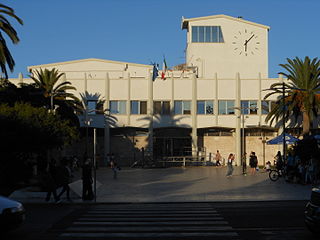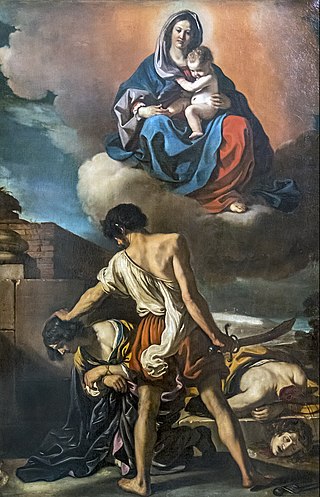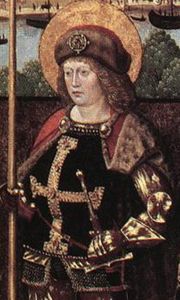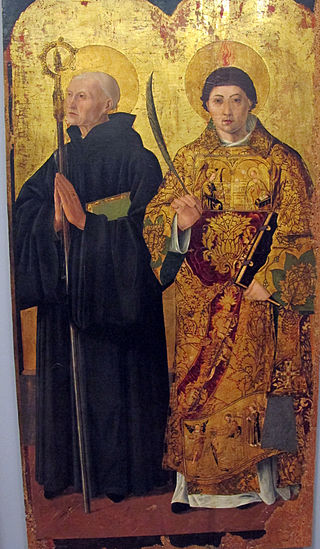
Gavinus (Italian : San Gavino) is a Christian saint who is greatly celebrated in Sardinia, Italy, as one of the Martyrs of Torres (Martiri turritani), along with his companions Protus, a bishop, and Januarius, a deacon.

Gavinus (Italian : San Gavino) is a Christian saint who is greatly celebrated in Sardinia, Italy, as one of the Martyrs of Torres (Martiri turritani), along with his companions Protus, a bishop, and Januarius, a deacon.
He was a Roman soldier martyred for the Christian faith during the persecution of Diocletian [1] in 304 in the city of Porto Torres (Latin : Turris), according to the legend, on the orders of the governor (preside) of Sardinia and Corsica, a certain Barbarus.
The earliest "passio" dates to the 12th century: Barbaro, who had been sent to Corsica and Sardinia, reached Turres and published the imperial edicts against the Christians, was denounced by Proto, Gavino and Gianuario. They were summoned to the tribunal and being steadfast in refusing to sacrifice to the gods, were summarily beheaded. [2]
A second, longer, "passio", from the middle of the thirteenth century, follows standard medieval hagiographical conventions. In this, Protus and Januarius are arrested and subjected to torture. Gavinus is a soldier conveying them to prison. Impressed with their courage, he releases them and asks for their prayers. The next day Gavinus was arrested for failing to produce his prisoners, and when he declared himself a Christian, was beheaded on the shore. Hearing that Gavinus had preceded them in martyrdom, Protus and Januarius returned to the city, were arrested, and likewise beheaded. [3] The story of the martyrdom was distributed in nine readings for use in the recitation of Matins.

The well-known Romanesque church of San Gavino in Gavoi is dedicated to him, as is the town of San Gavino Monreale, and a number of communes in Corsica. [2]
The 11th-century Basilica of San Gavino in Porto Torres, is also dedicated to this saint. It was built by Comita or Gomida, Judge of Torres, and contains the relics, not only of Gavinus, but also of his companions, Protus and Januarius. [4] According to legend, Gavinus appeared to Comita and requested he build the church. The relics of the saints were discovered in the crypt 1614.
Gavinus is one of the patron saints of Sassari. [5]
Gavinus is the patron saint of Porto Torres, Sardinia, and of Camposano, Campania. [3]
His feast day is given in the Roman Martyrology as 30 May.

Porto Torres is a comune (municipality) and a city of the Province of Sassari in north-west of Sardinia, Italy. Founded during the 1st century BC as Colonia Iulia Turris Libisonis, it was the first Roman colony of the entire island. It is situated on the coast at about 25 kilometres (16 mi) east of Falcone Cape and in the center of the Gulf of Asinara. The port of Porto Torres is the second biggest seaport of the island, followed by the port of Olbia. The town is very close to the main city of Sassari, where the local university takes office.

Saint Valentine was a 3rd-century Roman saint, commemorated in Western Christianity on February 14 and in Eastern Orthodoxy on July 6. From the High Middle Ages, his feast day has been associated with a tradition of courtly love. He is also a patron saint of Terni, epilepsy and beekeepers. Saint Valentine was a clergyman – either a priest or a bishop – in the Roman Empire who ministered to persecuted Christians. He was martyred and his body buried on the Via Flaminia on February 14, which has been observed as the Feast of Saint Valentine since at least the eighth century.

Januarius, also known as Januarius I of Benevento, was Bishop of Benevento and is a martyr and saint of the Catholic Church and the Eastern Orthodox Church. While no contemporary sources on his life are preserved, later sources and legends claim that he died during the Great Persecution, which ended with Diocletian's retirement in 305.

Pancras was a Roman citizen who converted to Christianity and was beheaded for his faith at the age of fourteen, around the year 304. His name is Greek (Πανκράτιος) and means "all-powerful".
Saint Gabinus is the title given to two personages.

John and Paul are saints who lived during the fourth century in the Roman Empire. They were martyred at Rome on 26 June. The year of their martyrdom is uncertain according to their Acts; it occurred under Julian the Apostate (361–363).

Saints Protus and Hyacinth were Christian martyrs during the persecution of Emperor Valerian. Protus' name is sometimes spelled Protatius, Proteus, Prothus, Prote, and Proto. His name was corrupted in England as Saint Pratt. Hyacinth is sometimes called by his Latin name Hyacinthus.

Saint Proculus (Proclus) of Pozzuoli was martyred around 305 AD, according to Christian tradition, at the same time as Saint Januarius.

Gereon of Cologne, who may have been a soldier, was martyred at Cologne by beheading, probably in the early 4th century.

The Archdiocese of Sassari is a Latin archdiocese of the Catholic Church in Sardinia, Italy. Its see was initially at Torres. It was elevated to an archdiocese in 1073.
San Gavino or San-Gavino may refer to:

Saints Cantius, Cantianus, and Cantianilla are venerated as saints and martyrs by the Christian church.

Saints Victor and Corona are two Christian martyrs. Victor was a Roman soldier who was tortured and killed; Corona was killed for comforting him. Corona is invoked as a patron of causes involving money; she was not historically associated with pandemics or disease, but has been invoked against the coronavirus pandemic.
Saint Caesarius of Terracina was a Christian martyr. The church of San Cesareo in Palatio in Rome bears his name. He is venerated as a saint in the Eastern Orthodox Church and Roman Catholic Church, with a feast day on 1 November.

Saints Marcellinus and Peter are venerated within the Catholic Church as martyrs who were beheaded. Hagiographies place them in 4th century Rome. They are generally represented as men in middle age, with tonsures and palms of martyrdom; sometimes they hold a crown each.

Saint Sossius or Sosius was Deacon of Misenum, an important naval base of the Roman Empire in the Bay of Naples. He was martyred along with Saint Januarius at Pozzuoli during the Diocletian Persecutions. His feast day is September 23, the date, three days after his death, on which his corpse was translated to Misenum.
Simplicius, Constantius and Victorinus are venerated as Christian martyrs of the 2nd century. Simplicius, was, according to tradition, a Christian of the Abruzzi region who was executed along with his two sons, Constantius and Victorian, during the reign of Marcus Aurelius. Their Passio contains all of the tropes of the genre. It is believed that the martyrdoms are genuine but that the three martyrs were not necessarily related to one another, but were executed together at Marsica.

The Basilica di San Gavino is a proto-Romanesque church in Porto Torres, Sardinia, Italy. A former cathedral, it is now a place for the veneration of local martyrs and a parish church.
Francisco d'Esquivel or Desquivel was a Spanish archbishop and a major figure in the history of Sardinia.

Luxurius or Luxorius was an ancient Roman official on Sardinia in the late 3rd and early 4th centuries. Apparitor to Delphius, the praeses or governor of the island, he was converted to Christianity by reading the Psalms. He possibly was beheaded on 21 August for refusing to sacrifice to idols in the city of Forum Traiani, probably in 304 during the fourth of Diocletian's persecutions. Later he was venerated as a martyr and saint by the Roman Catholic Church.